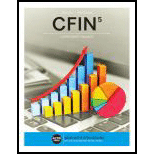
CFIN (with Online, 1 term (6 months) Printed Access Card) (New, Engaging Titles from 4LTR Press)
5th Edition
ISBN: 9781305661653
Author: Scott Besley, Eugene Brigham
Publisher: Cengage Learning
expand_more
expand_more
format_list_bulleted
Concept explainers
Question
Chapter 8, Problem 4PROB
Summary Introduction
Expected
Standard deviation is the financial measure of risk and stability on the
Coefficient of variance is a measure used to calculate the total risk per unit of return of an investment.

Expert Solution & Answer
Trending nowThis is a popular solution!

Students have asked these similar questions
The maturity value of an $35,000 non-interest-bearing, simple discount 4%, 120-day note is:
Carl Sonntag wanted to compare what proceeds he would receive with a simple interest note versus a simple discount note. Both had the same terms: $18,905 at 10% for 4 years. Use ordinary interest as needed.
Calculate the simple interest note proceeds.
Calculate the simple discount note proceeds.
What you're solving for
Solving for maturity value, discount period, bank discount, and proceeds of a note.
What's given in the problem
Face value:
$55300
Rate of interest:
10%
Length of note:
95
days
Date of note: August 23rd
Date note discounted: September 18th
Bank discount rate:9 percent
Chapter 8 Solutions
CFIN (with Online, 1 term (6 months) Printed Access Card) (New, Engaging Titles from 4LTR Press)
Knowledge Booster
Learn more about
Need a deep-dive on the concept behind this application? Look no further. Learn more about this topic, finance and related others by exploring similar questions and additional content below.Similar questions
- Please help me with this , with tge store name puebleo in St. Thomas US virgin islandsarrow_forwardI would like to expand pueblo in S5. Thomas virgin islands to Spain. Please help with an analysis expansion.arrow_forwardPlease help me with this, guidelines for the super market pueblo in St. Thomas US virgin islandsarrow_forward
- Need the below table filled out for Short-term debt %, Long-term debt $,%, Common equity $,% and Total capital $,%. Market Value Capital Structure Suppose the Schoof Company has this book value balance sheet: Current assets $30,000,000 Current liabilities $20,000,000 Notes payable 10,000,000 Fixed assets 70,000,000 Long-term debt 30,000,000 Common stock (1 million shares) 1,000,000 Retained earnings 39,000,000 Total assets $100,000,000 Total liabilities and equity $100,000,000 The notes payable are to banks, and the interest rate on this debt is 11%, the same as the rate on new bank loans. These bank loans are not used for seasonal financing but instead are part of the company's permanent capital structure. The long-term debt consists of 30,000 bonds, each with a par value of $1,000, an annual coupon interest rate of 6%, and a 15-year maturity. The going rate of interest on new long-term debt, rd, is 12%, and this is the…arrow_forwardNed assistance with Q3 and Q4 below? Cost of Equity The earnings, dividends, and stock price of Shelby Inc. are expected to grow at 6% per year in the future. Shelby's common stock sells for $21 per share, its last dividend was $1.00, and the company will pay a dividend of $1.06 at the end of the current year. Using the discounted cash flow approach, what is its cost of equity? Round your answer to two decimal places. 11.06 % If the firm's beta is 1.3, the risk-free rate is 8%, and the expected return on the market is 11%, then what would be the firm's cost of equity based on the CAPM approach? Round your answer to two decimal places. 11.90% If the firm's bonds earn a return of 9%, then what would be your estimate of rs using the own-bond-yield-plus-judgmental-risk-premium approach? (Hint: Use the mid-point of the risk premium range.) Round your answer to two decimal places. % On the basis of the results of parts a–c, what would be your estimate of Shelby's cost of equity?…arrow_forwardWhat monthly compounded interest rate would Second National Bank need to pay on savings deposits to provide an effective rate of 6.2%?arrow_forward
arrow_back_ios
SEE MORE QUESTIONS
arrow_forward_ios
Recommended textbooks for you
 EBK CONTEMPORARY FINANCIAL MANAGEMENTFinanceISBN:9781337514835Author:MOYERPublisher:CENGAGE LEARNING - CONSIGNMENT
EBK CONTEMPORARY FINANCIAL MANAGEMENTFinanceISBN:9781337514835Author:MOYERPublisher:CENGAGE LEARNING - CONSIGNMENT

EBK CONTEMPORARY FINANCIAL MANAGEMENT
Finance
ISBN:9781337514835
Author:MOYER
Publisher:CENGAGE LEARNING - CONSIGNMENT

Portfolio return, variance, standard deviation; Author: MyFinanceTeacher;https://www.youtube.com/watch?v=RWT0kx36vZE;License: Standard YouTube License, CC-BY